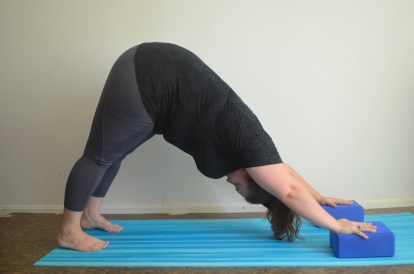Keeping it simple: Downward Dog with blocks

Happy Monday everyone! After taking Friday off from yoga blogging, I’m feeling like I have 12 different things to tell you! But, rather than inundate you with all of my thoughts from the last 5 days, I’m going to follow the advice of my yoga teachers and keep it simple. Before we get started on downward dog though, I want to take a moment to congratulate the newest batch of yoga teacher training graduates from Blue Heron Wellness. I had the good fortune to have a few of them observe my class as part of their training and it was always wonderful to chat with them, answer questions and talk about all things yoga teaching!
So downward dog…while this pose might not be the king (headstand according to traditional texts) of yoga poses, I do think it is the most ubiquitous. There are good reasons for this – it’s a good transition pose, and, once you practice for a while, it’s a good resting pose (my new students always snort when I tell them this after trying it for the first time). Downward dog is also a multifunctional pose. It’s a forward bend, a backbend, an inversion, an arm balance and a standing pose all in one.
I think most of you are probably familiar with the “upside down V position” us yoga teachers talk about all the time, but just in case, here’s a photo for you:
My hands are on blocks in this photo. For me, this is a key adjustment to making downward dog a resting pose rather than a why did I get started on this crazy yoga stuff, get me out of here pose.
My arms are a little on the short side compared to the rest of me…ok, it’s possible that my yoga nickname is “Short Arms Carlin”. Without the added arm length I get from the blocks, it’s quite difficult for me to distribute my weight evenly between my arms and legs. When they first try downward dog, most students carry the entire weight of the pose in their arms and wrists, which is why I get that snort when I suggest they might rest in the pose.
Adding the blocks can be revelatory, but keep in mind that if your arms are on the longer side, this hack might not work for you at all. Don’t get frustrated! You can play around with the block height, or ditch them entirely and look for a different set up that works for you. You can always comment if you need suggestions or email me.




Comments
3 Responses to “Keeping it simple: Downward Dog with blocks”Trackbacks
Check out what others are saying...[…] things that the Washington Post article highlighted was my use of wall dog as an alternative to downward facing dog. I realized I hadn’t posted about wall dog on the blog yet, so I will remedy that right […]
[…] it’s helpful to think of L-shaped handstand as the third pose in group comprised of wall dog, downward facing dog and L-shaped handstand. If you think about it, especially if you are a visually oriented learner, […]
[…] could also try downward dog with blocks underneath your hands. If you slip on your mat, orient yourself so the blocks push into the wall […]